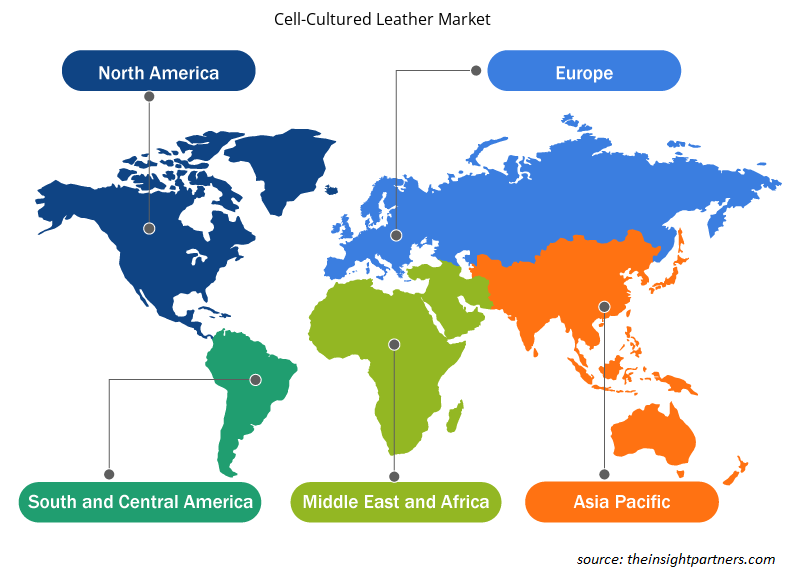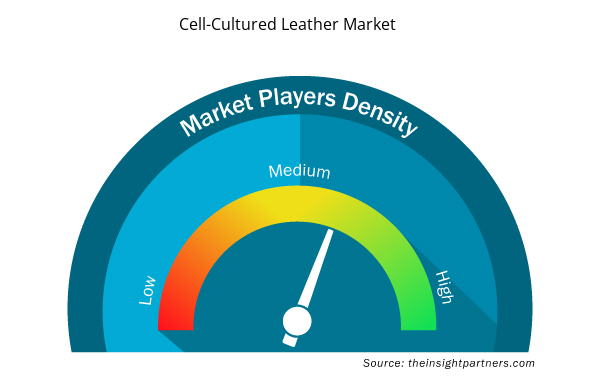[Research Report] The cell-cultured leather market size was valued at US$ 4.05 million in 2022 and is expected to reach US$ 8.15 million by 2030; it is estimated to register a CAGR of 9.1% from 2022 to 2030.
Market Insights and Analyst View:
Cell-cultured leather is made from yeast cells, bio-based scaffolds, collagen, and bioreactors. The players in the cell-cultured leather market make cell-cultured leather by using their patented technology. Cell-cultured leather is used in applications such as automotive, footwear, luggage and bags, apparel, and others. The rising demand for sustainable and cruelty-free leather mainly drives the market for cell-cultured leather. Moreover, beneficial properties such as durability, strength, and less environmental footprints are other factors driving the cell-cultured leather market growth. Further, many companies and brands are moving away from synthetic materials to make their leather fully compostable and biodegradable. With this, the demand for cell-cultured leather is increasing and is expected to grow further in the coming years. Furthermore, North America and Europe are major regions for the cell-cultured leather market. The demand for cell-cultured leather in these regions is driven by rising awareness about the traditional leather manufacturing process and the rising consumer demand for sustainable products.
Growth Drivers and Challenges:
Over the recent years, a lot of concern has been raised about the animal cruelty factors and the environmentally harmful effects associated with leather tanning and production. Several livestock animals are slaughtered in order to obtain leather through conventional methods. Moreover, raising these animals requires a lot of resources in terms of land and water. Cattle rearing is responsible for a significant percentage of global greenhouse gas emissions every year. The tanning process is also highly polluting, in which animal skins and hides are treated to produce leather. Nearly 80–90% of leather is treated with chromium. Chromium is a toxic chemical that pollutes waterways if not disposed of properly. It can also harm the health of workers who use it. Thus, the rising ethical and environmental concerns about traditional leather manufacturing have propelled the need for alternatives, such as cell-cultured leather. Cell-cultured leather is a more sustainable alternative to current practices in the leather production process. Cell-cultured leather overcomes the need for animal slaughtering and also helps reduce carbon emissions associated with leather production. Cell-cultured leather production reduces some of the dangers and toxins involved in leather tanning. It is beneficial for the environment and workers in the leather industry. However, the availability of substitute products in the market hampers the cell-cultured leather market growth. The substitute products for cell-cultured leather are traditional leather, leather made from polyurethane, polyvinyl chloride, and bio-based materials. There are various advantages of traditional leather over other alternatives, such as it lasts for a long time. Also, unlike most man-made or synthetic materials, it gets better with age. Further, leather made from polyurethane and polyvinyl chloride is cost-effective. Bio-based leather is made from mushrooms, pineapple, apple, cactus, and tree bark; it is more environment-friendly and cruelty-free. The rise of veganism is making people demand leather produced from these bio-based materials. As cell-cultured leather is made from animal cells, it negates the possibility of claiming the label as vegan or animal-free.
Customize This Report To Suit Your Requirement
You will get customization on any report - free of charge - including parts of this report, or country-level analysis, Excel Data pack, as well as avail great offers and discounts for start-ups & universities
Cell-Cultured Leather Market: Strategic Insights

- Get Top Key Market Trends of this report.This FREE sample will include data analysis, ranging from market trends to estimates and forecasts.
Customize This Report To Suit Your Requirement
You will get customization on any report - free of charge - including parts of this report, or country-level analysis, Excel Data pack, as well as avail great offers and discounts for start-ups & universities
Cell-Cultured Leather Market: Strategic Insights

- Get Top Key Market Trends of this report.This FREE sample will include data analysis, ranging from market trends to estimates and forecasts.
Report Segmentation and Scope:
The global cell-cultured leather market is segmented on the basis of application and geography. Based on application, the cell-cultured leather market is segmented into automotive, footwear, luggage and bags, apparel, and others. By geography, the cell-cultured leather market is segmented into North America, Europe, Asia Pacific, and Rest of the world.
Segmental Analysis:
Based on application, the cell-cultured leather market is segmented into automotive, footwear, luggage and bags, apparel, and others. The apparel segment held the largest share in the cell-cultured leather market and is expected to register significant growth over the studied period. In the apparel industry, jackets, coats, pants, shirts, etc. can be made from cell-cultured leather. Various companies in the apparel industry are focusing on developing sustainable fashion products, which entails using sustainable materials. Many brands are proactively designing sustainability into their strategy, and consumers are also highly demanding sustainable fashion products. Different initiatives by brands and companies further provide an opportunity for the cell-cultured leather market growth.
Regional Analysis:
Based on geography, the cell-cultured leather market is segmented into key regions—North America, Europe, Asia Pacific, and Rest of the World. The global cell-cultured leather market was dominated by North America, which accounted for over US$ 2 million in 2022. In North America, the rising demand for footwear, luggage, and bags, as well as clothing products, along with a growing focus on using sustainable products, is providing opportunities for the cell-cultured leather market growth. Europe is the second-largest contributor, which is expected to register a significant growth rate from 2022 to 2030. Europe is one of the major regions for the cell-cultured leather market. The rapid growth of demand for sustainable products in European countries such as France, the UK, Germany, and Italy offers a huge market growth potential for the cell-cultured leather market. Various luxury fashion brands such as Hermes and Balenciaga are championing leather alternatives, providing opportunities for the cell-cultured leather market growth.
Industry Developments and Future Opportunities:
Various initiatives taken by the key players operating in the cell-cultured leather market are listed below:
- In 2022, VitroLabs Inc raised US$ 46 million to build and scale the world's first pilot production of cell-cultivated leather. The Series A funding is led by Agronomics; other investors include BESTSELLER's Invest FWD, global luxury group Kering, Khosla Ventures, actor and environmentalist Leonardo DiCaprio, New Agrarian, and Regeneration.VC. Moreover, Kering continues its partnership with VitroLabs Inc in bringing support for product quality testing, tanning, and finishing.
- In 2021, Qorium raised € 2.6 million (US$ 2.75 million) to expand research and development to scale up its cell-cultured collagen-based leather technology.
- In 2023, Modern Meadow raised Series D funding. The funding is led by Astanor Ventures, Horizons Ventures, and Key Partners Capital, which will support Modern Meadow to continue its innovation.
Cell-Cultured Leather Market Regional Insights
Cell-Cultured Leather Market Regional Insights
The regional trends and factors influencing the Cell-Cultured Leather Market throughout the forecast period have been thoroughly explained by the analysts at Insight Partners. This section also discusses Cell-Cultured Leather Market segments and geography across North America, Europe, Asia Pacific, Middle East and Africa, and South and Central America.

- Get the Regional Specific Data for Cell-Cultured Leather Market
Cell-Cultured Leather Market Report Scope
| Report Attribute | Details |
|---|---|
| Market size in 2022 | US$ 4.05 Million |
| Market Size by 2030 | US$ 8.15 Million |
| Global CAGR (2022 - 2030) | 9.1% |
| Historical Data | 2020-2021 |
| Forecast period | 2023-2030 |
| Segments Covered |
By Application
|
| Regions and Countries Covered | North America
|
| Market leaders and key company profiles |
Cell-Cultured Leather Market Players Density: Understanding Its Impact on Business Dynamics
The Cell-Cultured Leather Market market is growing rapidly, driven by increasing end-user demand due to factors such as evolving consumer preferences, technological advancements, and greater awareness of the product's benefits. As demand rises, businesses are expanding their offerings, innovating to meet consumer needs, and capitalizing on emerging trends, which further fuels market growth.
Market players density refers to the distribution of firms or companies operating within a particular market or industry. It indicates how many competitors (market players) are present in a given market space relative to its size or total market value.
Major Companies operating in the Cell-Cultured Leather Market are:
- VitroLabs Inc
- MODERN MEADOW
- Qorium
Disclaimer: The companies listed above are not ranked in any particular order.

- Get the Cell-Cultured Leather Market top key players overview
COVID-19 Impact:
Before the pandemic, the market for cell-cultured leather was mainly driven by the increasing demand for cruelty-free leather from various end-use sectors. The COVID-19 pandemic affected almost all industries in various countries. Lockdowns, travel restrictions, and business shutdowns in North America, Europe, Asia Pacific, and Rest of the World hampered the growth of several industries, including the chemical & materials industry. The shutdown of manufacturing units of companies disturbed global supply chains, manufacturing activities, and delivery schedules. Various companies witnessed delays in product deliveries and a slump in sales of their products in 2020. The pandemic introduced various economic challenges, which negatively impacted the cell-cultured leather market growth in different regions. Most of the industries, such as automotive, footwear, and apparel, were negatively impacted by the pandemic, decreasing the consumption of cell-cultured leather. The pandemic adversely impacted research and development activities as well as partnership and collaboration projects related to cell-cultured leather. The shutdown of automotive production due to the pandemic reduced the demand for different products, including leather.
However, various industries revived their operations after supply constraints were resolved. Moreover, the rising demand for cell-cultured leather from automotive, footwear, and apparel industries is substantially promoting the cell-cultured leather market growth.
Competitive Landscape and Key Companies:
A few key players operating in the cell-cultured leather market are VitroLabs Inc, MODERN MEADOW, and Qorium. Players operating in the market focus on research and development activities to produce high-quality products to fulfill customer demand from various application industries.
- Historical Analysis (2 Years), Base Year, Forecast (7 Years) with CAGR
- PEST and SWOT Analysis
- Market Size Value / Volume - Global, Regional, Country
- Industry and Competitive Landscape
- Excel Dataset



Report Coverage
Revenue forecast, Company Analysis, Industry landscape, Growth factors, and Trends

Segment Covered
Application

Regional Scope
North America, Europe, Asia Pacific, Middle East & Africa, South & Central America

Country Scope
This text is related
to country scope.
Frequently Asked Questions
A few players operating in the global cell-cultured leather market include VitroLabs Inc, MODERN MEADOW, and Qorium.
In 2022, North America held the largest share of the global cell-cultured leather market. In North America, the rising demand for footwear, luggage, and bags, and clothing products, along with a growing focus on using sustainable products, are providing opportunities for the cell-cultured leather market growth.
The apparel segment held the largest share in the global cell-cultured leather market in 2022. In the apparel industry, jackets, coats, pants, shirts, etc., can be made from cell-cultured leather.
The projected growth of the market is attributed to the rising demand for sustainable and cruelty-free leather.
Europe is estimated to register the fastest CAGR in the global cell-cultured leather market from 2022 to 2030. The rapid growth of demand for sustainable products in European countries such as France, the UK, Germany, and Italy offers a huge market growth potential for the cell-cultured leather market.
The footwear segment is estimated to register the fastest CAGR in the global cell-cultured leather market from 2022 to 2030. In the footwear industry, cell-cultured leather finds application in making boots, shoes, slippers, sneakers, sandals, loafers, and more products.
Trends and growth analysis reports related to Chemicals and Materials : READ MORE..
The List of Companies - Cell-Cultured Leather Market
- VitroLabs Inc
- MODERN MEADOW
- Qorium

 Get Free Sample For
Get Free Sample For